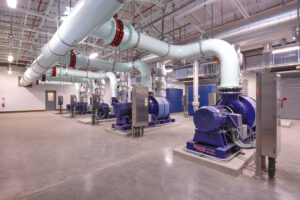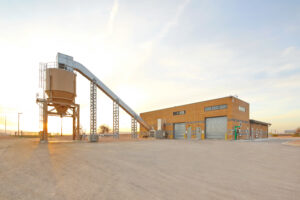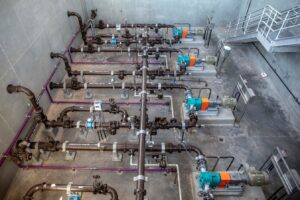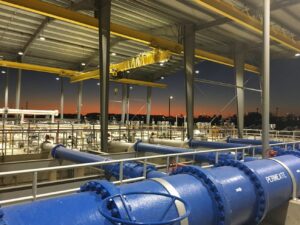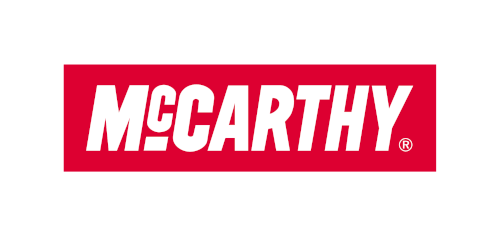Challenge
For years, the City of Chandler (City), Arizona, has relied on the Airport Water Reclamation Facility (AWRF) to pump reclaimed water to the south Chandler area. However, the Ocotillo Water Reclamation Facility (OWRF) is located closer to many of the City’s reclaimed water users such as the Ocotillo Management Group, the Gila River Indian Community (GRIC), and the Ocotillo Aquifer Storage and Recovery (ASR) Wells. To satisfy the need to accommodate growth and to augment the City’s ability to treat domestic and industrial influent wastewater and produce reclaimed water closer to these users, the City selected the joint venture of Sundt Construction, Inc., and McCarthy Building Companies, Inc., to design and build a new $122 million expansion to the OWRF (at the time, the largest wastewater project in the state completed in the previous year). The expansion was designed around a new membrane bioreactor (MBR) treatment train that included suspended bacterial growth within aeration basins (bioreactor) to remove biochemical oxygen demand (BOD) and nitrogen and provide solids-liquids separation via submerged membrane filtration.
The facility was originally designed in 1984 as a 10 million gallons per day (mgd) conventional treatment plant, including conventional activated sludge process with biological nutrient removal, followed by tertiary filtration and disinfection. Due to rapid growth and the City’s vision to provide both sufficient wastewater treatment capacity for future development and high-quality reclaimed water to its end users, as well as the need to address aging infrastructure, planning for the expansion began in 2014. The expansion was designed around a new MBR treatment train to reliably produce consistent Class A+ reclaimed water using submerged membrane filtration technology.
Phase 1 of the OWRF expansion added 5.5 mgd with an MBR treatment train for a new facility rated capacity of 15.5 mgd. As the selected construction manager at-risk (CMAR), the joint venture of Sundt/McCarthy began construction of Phase 1 in October 2016 and obtained substantial completion in May 2018 and final completion in October 2018.
The Phase 1 OWRF expansion included the construction of several new facilities and improvements to the existing facility, such as:
- Modifications to the existing airport lift station to serve as a new influent pump station (IPS) while retaining flexibility to send flow to the City’s AWRF
- New headworks building, including coarse screens, fine screens, and screenings disposal
- Two new bioreactors, including process blowers, diffusers, submersible mixers, and online analyzers
- New membrane filtration system, including submerged hollow-fiber filters, air scour blowers, permeate pumps, backpulse tank, chemical cleaning storage and feed facility, RAS pumping, and WAS/scum pumping
- New chlorine contact basin
- New sodium hypochlorite storage and feed system
- New reclaimed water pump station
- New sludge holding tanks, including process blowers, diffusers, and dewatering feed pumps
- New solids dewatering building, including belt filter presses, solids conveyor, and dewatered cake storage silo
- New solids area drain pump station
- New odor control systems for the IPS, headworks building, sludge holding tanks, and dewatering building
- New 100-foot-diameter secondary clarifier
- New administration building
- New maintenance building
- Additional standby generation capacity
- Two new electrical service feeds
- New process control interface system (PCIS)
Approach
Based on previous experience with similar projects, the City decided at the onset to deliver the OWRF expansion project using the CMAR integrated project delivery approach. Primary drivers included early cost certainty, open-book cost model transparency, collaboration of all stakeholders throughout the entire project, and the ability to effectively sequence construction activities that included critical modifications to the existing treatment train needed to facilitate the new treatment facilities. Using a qualifications-based selection (QBS) approach, the City selected the Sundt/McCarthy JV shortly after the engineer developed the basis of design report (BDR) as part of the initial programming phase.
To save capital costs while increasing treatment capacity, the project team employed innovative approaches, including the construction of combined facilities that could serve both the existing conventional and the new MBR treatment trains. The conventional and MBR treatment trains now utilize shared headworks, solids handling, and reclaimed water pumping facilities to replace older, less efficient systems.
Many benefits arise from combining facilities. Creating a common headworks facility with new coarse and fine screens reduces life cycle osts and eliminates the need for the existing headworks facility that continued to struggle to meet the needs of the plant. Waste-activated sludge from both treatment trains are combined at the new sludge holding tanks where they are then pumped to the new solids dewatering building. This new building is operator friendly, with access to the polymer feed systems, belt filter presses, and solids conveyor all within the single-floor building. Dewatered cake solids are loaded into a storage silo where they can be loaded into a truck for disposal at a local landfill. The combined solids handling facility simplifies operations and reduces overall maintenance costs, as well as replacing the aging infrastructure at the existing treatment plant.
Effluent from both treatment trains combines at the reclaimed water pump station where it can be pumped to the Gila River Indian Community, aquifer storage and recovery wells, Ocotillo Management Group, Intel, emergency storage basins, and the plant water (non-potable) system. Prior to its construction, flow to each of these users was sent from several different, aging pump stations. The combined pump station simplifies operations and reduces overall maintenance costs.
Results
The OWRF expansion has been programmed to allow for an ultimate buildoutcapacity of 30 mgd, on land adjacent to the existing OWRF to the north and west, over several phases. The preliminary design development stage focused on planning the site through the phases to the 40 mgd buildout (new 30 mgd trains plus existing 10 mgd train). This planning included provisions to allow ease of future expansions, such as diversion structures, piping corridors, electrical ductbank corridors, footprints for all treatment facilities, and piping to maintain minimum and maximum flow rates through all phases, to ultimately avoid future costly plant shutdowns or bypassing.
During the Phase 1 OWRF expansion, the team faced many challenges, including maintaining operations of the existing OWRF during the construction activities. There were over 30 scheduled shut-down events where construction activities impacted plant operations. Through the use of effective coordination meetings between City operations staff, the engineer, and Sundt/McCarthy, the plant maintained permit discharge requirements at all times of construction. The on-site construction team collaborated to create a seamless safety culture with all trades, crews, and supervisors that resulted in zero recordable incidents or lost-time accidents throughout the entire construction phase. Despite ~474,000 total man-hours on the job and the majority of the workforce being local, this “perfect” safety record was a tremendous accomplishment for the community at large with long-lasting social impacts.
The City’s expectations were also exceeded when the final construction project came in under budget. The City, the engineer, and Sundt/McCarthy worked together to reallocate direct cost savings in excess of $6.5 million for increased redundancy by adding a new secondary clarifier, medium voltage standby generators, additional membrane cassettes, and a larger GRIC reclaimed water pipeline, allowing additional desired upgrades to the WRF that would have otherwise been deferred for future improvement. In January 2019, the installation of the additional membrane cassettes, installed with a portion of those direct cost savings, resulted in ADEQ approval of an increase to the OWRF’s rated capacity from 15.5 mgd to 18.0 mgd. This facility rerating allowed the City to quickly and cost-effectively expand their distribution of Class A+ reclaimed water in Chandler.
The project was awarded the 2019 Wastewater Treatment Plant of the Year by the Arizona Water Association.
“On the Ocotillo Water Reclamation Facility project, commissioning and startup began in preconstruction. Our project team was bought into the plan over a year in advance of commencing preliminary checkout activities. They partnered with our plant operations team and continuously refined the plan to ensure all stakeholders’ needs were met. This proactive, collaborative process led to one of the most seamless and successful plant startups our team has ever delivered.”
—John Knudson, Public Works & Utilities Director, City of Chandler

